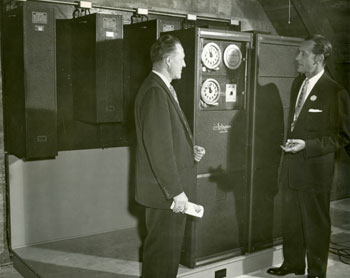I should hope that most of us are familiar with the Kilworth Memorial Chapel located on the Northern edge of campus. A spiritual center for students, the chapel itself was built with funds left to the University in 1967 in the will of one William Washington Kilworth, a local entrepreneur and board of trustees member. However the chapel, while impressive, is far from the most interesting thing that Mr. Kilworth donated to the University, to say nothing of the man himself.
Mr. Kilworth earned his fortune in the logging industry. When he first arrived in the Pacific Northwest after moving from Kansas, lumber was Washington’s single largest export, and he had a plan to integrate himself into the system. Purchasing the slabs of bark-covered wood that most mills considered wasteful byproducts, Kilworth began producing and selling broom handles, and as it turns out, he was spectacularly successful at it. After several years, his company sold more than seventy five percent of all broom handles used in America, and Kilworth, at the head of it all, was more than well off financially. A generous philanthropist, Kilworth was unafraid to spend his money where he thought it was needed. A civic leader in Tacoma, he donated to boy scout troops, churches, and seminaries. It was around this time that he became a trustee here at the University. He was, however, not without some peculiarities.
Kilworth was a grand connoisseur of bell towers. And being that he had plenty of money on hand for donations, his intentions were clear; he would donate the money to have a bell tower named after him. His first offer he made to the city of Seattle, but they quickly refused him. His second offer, naturally, was to the University of Puget Sound. Unfortunately, not only did the University have little to no need or desire for a bell tower, but no one was willing to shell out the $200,000 (around $1.5 million in today’s money) needed to build one on the University campus. Kilworth, however, would have nothing of it. His money was going to be used to build a bell tower, or it was not going to be used at all.
Kilworth and the University faculty eventually came to an unsteady agreement: No tower would be built, nor any bells commissioned. Instead, his donation would be used to purchase an electronic carillon to be placed in the music building. Reproducing sound on a computer nowadays may be a simple task, but in 1954, it needed several very large and very expensive racks of electronics. In fact, the total donation that he had originally pledged to build a tower was spent entirely on purchasing the carillon, and it filled the entire attic of the music room it was installed in.
To read more about W.W. Kilworth and other University figures, check out President Thompson’s histories online at Sound Ideas. Find the above photograph in A Sound Past.
By Zebediah Howell

